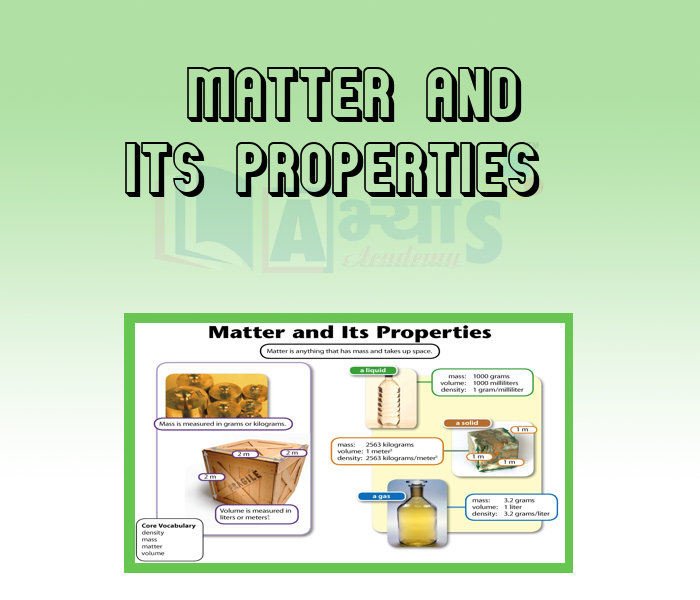Matter And Its Properties

Matter And Its Properties
Properties Of Matter: Matter possesses several properties. However, we shall discuss a few as under
Diffusion: It is the process where molecule of a substance penetrates another substance. Ii is known to of a liquid. i.e. gases and liquids. For example, LPG when it leaks, its smell can be felt in the nearby air.
Evaporation and Sublimation: It is the phenomenon when a particle on the surface of a liquid or a solid acquires enough to overcome the attractive forces that hold it as part of the substance, it escapes and becomes a particle of vapour or gas. Wind, heat and surface area affect the rate of evaporation of a liquid. When such vaporisation takes place in solids, it is known as sublimation.
Cohesion and Adhesion: Cohesion refers to the force of attraction between molecules of the same substance, eg. the molecules of liquid water in a glans. However, the force of attraction between molecules of different substances is called adhesion, For example, a postage stamp can be affixed to paper by applying gum. Then the force of attraction between the gum and paper is known as adhesion.
Surface Tension: Molecules at the surface of a liquid feel a strong downward force of pull as they have no liquid molecules above. Hence, as compared to other molecules inside the vessel, which experience equal forces of downward pull and upward poll, molecules at the surface feel very weak upward pull force and resultantly strong downward force. It results in the tendency of a liquid surface to constraint and occupy the minimum area possible. This is called surface tension. This tension makes the area of the free surface as small as possible and makes the liquid surface behave like a piece of stretched rubber.
Osmosis: Certain substances are porous to one material, but not to another. For example, water will diffuse through a thin slice of potato, but sugar molecules will not. A membrane of this sort is called a semi-permeable membrane. The selective diffusion through such a membrane is known as osmosis Osmosis plays an important part in carrying liquids through plants, and in the absorption of food and disposal of waste by cells in plants and animals. It explains how food passes through the walls of intestines, and also explains in part how sap is forced to the top of a tree.
Viscosity: If you stir some water in a glass with a spoon and then stop stirring, the water continues to swirl more and more slowly until it comes to rest. If you had stirred honey or treacle instead of water, it would have come to rest much more quickly. Internal friction in treacle or honey is greater than internal friction, or resistance to motion, in water. The Viscosity of a fluild is the property it possesses of resisting the movement of its various parts. Viscosity is the internal friction of a fluid.
Elasticity - Hooke's Law: A solid rubber ball can be squeezed, stretched, bent or twisted, it will still revert to its original shape when the distorting force is removed. This property, which enables it to accomplish this, is called elasticity. It is defined as the property of matter by which a solid requires a certain amount of force to distort it, and then tends to resume its original shape when the distorting force is removed. The force per unit area, which tends to distort the body, is called stress. The relative amount of distortion thus produced is called strain. The stress changes the distances between the particles, either pulling them farther apart or pushing them closer together. When the stress is removed, forces between the particles restore them to their normal spacing.
Other Properties of Solids: A number of other properties of solids, such as ductility, malleability. hardness and brittleness, depend on the type and arrangement of the elementary crystals. Ductility is the property that determines to what extent a solid can be drawn out into fine threads. Tungsten is an extremely ductile solid material. Quartz is another very ductile material. The property of malleability refers to the extent to which a material can be made into thin sheets. Gold is one of the most malleable of all solids. Resistance to scratching of a surface is called hardness. Diamond, corundum, and topaz are all very hard. A scale called Mohs Scale is used to indicate the degree of hardness of minerals. Brittleness refers to the tendency of a substance to crumble when subjected to a blow. A typical brittle substance is the familiar rock salt.
Students / Parents Reviews [20]
My experience with Abhyas academy is very nice or it can be said wonderful. I have been studying here from seven class. I have been completing my journey of three years. I am tinking that I should join Abhyas Academy in tenth class as I am seeing much improvement in Maths and English

Hridey Preet
9thUsually we see institutes offering objective based learning which usually causes a lag behind in subjective examinations which is the pattern followed by schools. I think it is really a work of planning to make us students grab the advantages of modes of examination, Objective Subjective and Onli...

Anika Saxena
8thI have spent a wonderful time in Abhyas academy. It has made my reasoning more apt, English more stronger and Maths an interesting subject for me. It has given me a habbit of self studying

Yatharthi Sharma
10thAbhyas academy is great place to learn. I have learnt a lot here they have finished my fear of not answering.It has created a habit of self studying in me.The teachers here are very supportive and helpful. Earlier my maths and science was good but now it has been much better than before.

Barkha Arora
10thIt has a great methodology. Students here can get analysis to their test quickly.We can learn easily through PPTs and the testing methods are good. We know that where we have to practice

Barkha Arora
10thAbhyas institute is one of the best coaching institute in the vicinity of Ambala cantt.The institute provides good and quality education to the students.The teachers are well experienced and are very helpful in solving the problems. The major advantages of the institute is extra classes for weak...

Shreya Shrivastava
8thMy experience with Abhyas is very good. I have learnt many things here like vedic maths and reasoning also. Teachers here first take our doubts and then there are assignments to verify our weak points.

Shivam Rana
7thWe started with lot of hope that Abhyas will help in better understnding of complex topics of highers classes. we are not disappointed with the progress our child has made after attending Abhyas. Though need to mention that we expected a lot more. On a scale of 1-10, we would give may be 7.

Manya
8thMy experience with Abhyas academy is very good. I did not think that my every subject coming here will be so strong. The main thing is that the online tests had made me learn here more things.

Hiya Gupta
8thA marvelous experience with Abhyas. I am glad to share that my ward has achieved more than enough at the Ambala ABHYAS centre. Years have passed on and more and more he has gained. May the centre flourish and develop day by day by the grace of God.

Archit Segal
7thIt was a good experience with Abhyas Academy. I even faced problems in starting but slowly and steadily overcomed. Especially reasoning classes helped me a lot.

Cheshta
10thBeing a parent, I saw my daughter improvement in her studies by seeing a good result in all day to day compititive exam TMO, NSO, IEO etc and as well as studies. I have got a fruitful result from my daughter.

Prisha Gupta
8thIn terms of methodology I want to say that institute provides expert guidence and results oriented monitering supplements by requsite study material along with regular tests which help the students to improve their education skills.The techniques of providing education helps the students to asses...

Aman Kumar Shrivastava
10thThe experience was nice. I studied here for three years and saw a tremendous change in myself. I started liking subjects like English and SST which earlier I ran from. Extra knowledge gave me confidence to overcome competitive exams. One of the best institutes for secondary education.

Aman Kumar Shrivastava
10thAbhyas Methodology is very good. It is based on according to student and each child manages accordingly to its properly. Methodology has improved the abilities of students to shine them in future.

Manish Kumar
10thAbhyas is an institute of high repute. Yogansh has taken admission last year. It creates abilities in child to prepare for competitive exams. Students are motivated by living prizes on basis of performance in Abhyas exams. He is satisfied with institute.

Yogansh Nyasi
7thThird consective year,my ward is in Abhyas with nice experience of admin and transport support.Educational standard of the institute recumbent at satisfactory level. One thing would live to bring in notice that last year study books was distributed after half of the session was over,though study ...

Ayan Ghosh
8thMy experience was very good with Abhyas academy. I am studying here from 6th class and I am satisfied by its results in my life. I improved a lot here ahead of school syllabus.

Ayan Ghosh
8thAbhyas is a complete education Institute. Here extreme care is taken by teacher with the help of regular exam. Extra classes also conducted by the institute, if the student is weak.

Om Umang
10thMy experience with Abhyas Academy has been very good. When I was not in Abhyas whenever teacher ask questions I could not speak it confidently but when I came in Abhyas, my speaking skills developed and now I am the first one to give the answer of teachers question.





